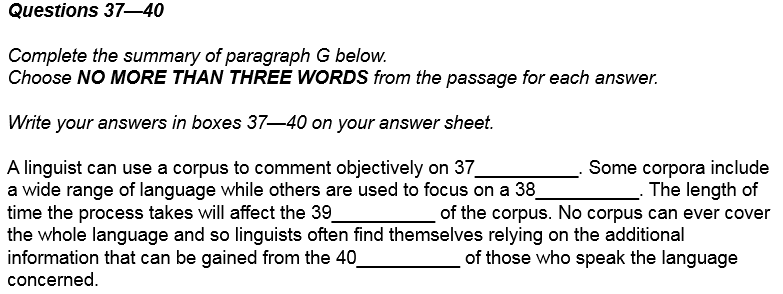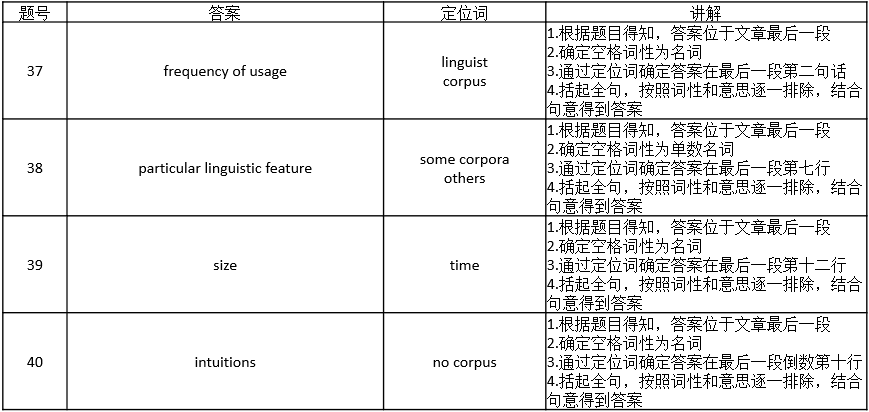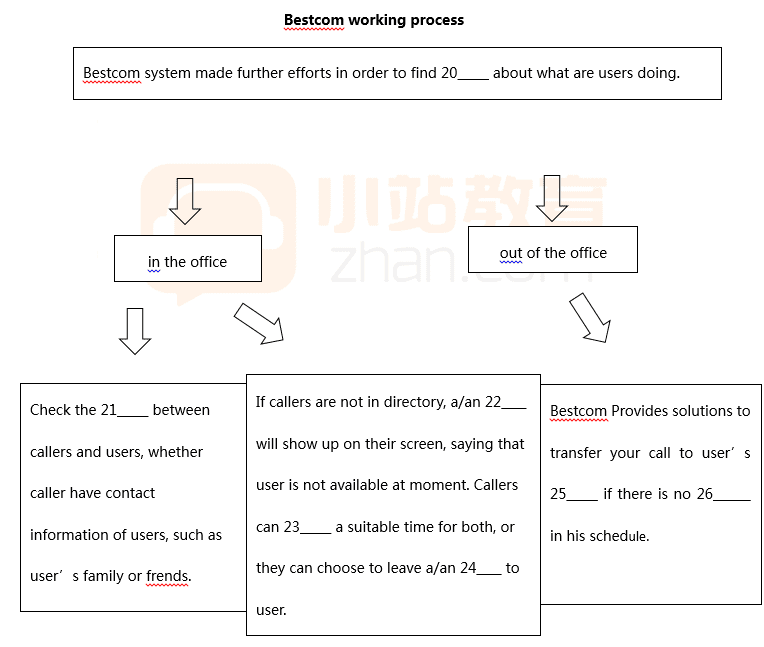俗話說“磨刀不誤砍柴工”~弄清楚雅思閱讀常見的14類題型及其相應的答題技巧,下面小編給大家帶來了雅思閱讀14類題型解題技巧之Multiple Choice(選擇題),下面小編就和大家分享,來欣賞一下吧。
雅思閱讀14類題型解題技巧--Multiple Choice(選擇題)
Multiple Choice(選擇題)
1. 題型要求
這是一個傳統題型,大家都很熟悉。但就是這種大家都熟悉的題型,IELTS考試也要弄出新花樣:四選一和多選多兩種。
四選一,選項肯定是四個。即要求從A、B、C、D四項中選擇一個最符合題意的選項。
多選多,選項肯定是五個或五個以上,而正確答案的數目肯定在兩個以上。
哪個更難呢?很多同學會好不猶豫地說是多選多。實際上,多選多很容易,是一種簡單題型。它具有以下幾個特點:
(1) 正確答案的數目是已知的。在題目的要求中會告訴你要選出幾個選項。題目要求中常WHICH FOUR, WHICH THREE 等字樣。
(2) 答案在原文中是集中出現的,對應原文中的例舉。找著一個答案,其余幾個就在它的前后不遠處。
我們舉一個中文閱讀的例子來說明。文章如下:
帕金森癥是一種頑癥。它是由大腦中缺乏一種叫多巴胺的化學物質引起的。(后面刪減100字)很多名人深受其苦。比如,我們的改革的總設計師鄧小平、拳王阿里、以故數學家陳景潤等等。(后面刪減100字)
題目是:以下哪三個人得過帕金森癥?
A. 鄧小平
B. 里根
C. 拳王阿里
D. 布什
E. 陳景潤 答案:ACE
四選一在考試中,一般比較難。它的特點是:四個選項,哪個都像。好像在原文中都提到了,但又都和原文的敘述不太一樣。很容易選錯。
選擇題和問答題的區別在于:問答題要求你自己從原文中找答案。而選擇題給你四個選項,讓你選擇,在給你提示的同時,也給了你一個陷阱。有些選擇題,如果改為回答題,你可能能夠做對,但給了你四個選項,反而選錯了。
考試中,四選一,A類和G類一般都是每次必考,考一組,共3題左右。多選多,不是每次必考。
2. 解題步驟
(1) 找出題干中的關鍵詞,最好先定位到原文中的一個段落。
將題干中的關鍵詞與原文各段落的小標題或每段話的第一句相對照。有些題目能先定位到原文中的一個段落,著必將大大加快解題時間,并提高準確率。但并不是每個題目都能先定位到原文中的一個段落的。
如果題目中的關鍵詞難以確定答案的位置,選項中的關鍵詞也可以作為定位的參考依據。
(2) 從頭到尾快速閱讀該段落,根據題干中的其他關鍵詞及選項確定正確答案。正確選項常常是原文相關詞句的改寫。
確定一個段落后,答案在該段落中有的具體位置是未知的。所以,需要從頭到尾快速閱讀該段落,確定正確答案。短問答的答案常常是原文原詞,而選擇題的答案常常是原文相關詞句的改寫。
(3) 有些題目比較簡單,可以直接選擇。對于難題,可以用排除法確定正確答案。
有些題目比較簡單,從原文很快找到對應答案。這時可以直接選擇不必看其它選項。既可以節省時間,同時也避免受干擾選項的誤導。
有些題目比較難,看每個選項都有點像,但又都不太象。這時,可以用排除法,先排除掉肯定不對的選項,然后在剩下的選項中再做出選擇。通常,有兩個選項必有好排除,另外兩個有一定的難度。請參見本題型的注意事項部分,其中分析了干擾選項的特點。
(4) 要注意順序性,即題目的順序和原文的順序基本一致。
題目是有順序性的。第一題的答案應在文章的前部,第二題的答案應在第一題的答案之后。這個規律也有助于同學們確定答案的位置。
NOTICE:
1. 如果一個選項合乎題意,還要看其它選項中是否有both…and、all of the above的字樣。
我們舉一個中文閱讀的例子:
原文:如果你隨便停車,要罰你款,還要把你的車拖走。
題目:如果你隨便停車,將:
A. 被罰款
B. 你的車被拖走
C. 沒事兒
D. both被罰款and你的車被拖走 答案:D
如果選項中有一個是all of the above,它是正確選項的可能性很大。Both…and是正確選項比all of the above小一些。總之,如果一個選項合乎題意,不要馬上選。看一眼其余選項中是否有both…and, all of the above的字樣。
2. 注意題干中是否有not, except的字樣。
題干中有這些詞時,通常是將它們大寫并使用黑體,特別醒目。如果不注意看,必然答錯題。
如前面的關于帕金森癥的中文閱讀文章,可能出一道四選一的題目:
題目:下面的人得過帕金森癥EXCEPT
A. 鄧小平
B. 里根
C. 拳王阿里
D. 陳景潤 答案:B
3. 干擾選項的特點
做選擇題的過程就是與干擾選項做斗爭的過程。清楚干擾選項的特點,就能做到百戰百勝。干擾選項特征如下:
A. 無:選項中所講的內容在原文中根本不存在,或找不到語言依據。要注意,答題的唯一依據是原文,不能憑借自己的知識或主觀想象。
B. 反:與原文相矛盾的選項。這時要注意題干或原文中是否有NOT、EXECPT等詞,也要注意反義詞。
C. 滿:含有“絕對意義”的詞匯如must、always、all、will的選項,一般為錯誤選項。選項中含有“相對意義”的詞匯如can、may、sometimes、some、not always,一般為正確答案。也就是說,越是模棱兩可、含含糊糊,越可能是正確答案,因為它適用的范圍更廣。這條規律的適用性很強,實踐證明它的準確率在90%以上。
D. 偏:似是而非,與原句部分相似的選項。這是不太容易排除的。
E. 混:張冠李戴,有時題干是主語,選項是謂語,要留心題干的主語和選項的謂語構成的主謂結構是否張冠李戴。這種干擾項規律也比較明顯,常常是這樣的:
原文:甲事物的特征是X。乙事物的特征是Y。
題干是甲事物,選項中肯定有特征Y,但肯定沒有特征X。為什么呢?特征Y就是讓你選的干擾項,如果選項中有特征X,你肯定會選它,就不會選錯了。也就是出題者為了這個精心布置的陷阱成功,他會舍棄特征X,而在文章的其它地方談到甲事物的時候,出現一個正確答案。
4. 正確選項應是原文的改寫,與原文特別一致的選項應引起懷疑。
正確選項應是原文相關詞句的改寫,所以與原文特別一致的選項是正確選項的可能性不大。
雅思閱讀摘要題講解--Obtaining Linguistic Data
Obtaining Linguistic Data
A
Many procedures are available for obtaining data about a language. They range from a carefully planned, intensive field investigation in a foreign country to a casual introspection about one's mother tongue carried out in an armchair at home.
B
In all cases, someone has to act as a source of language data — an informant. Informants are (ideally) native speakers of a language, who provide utterances for analysis and other kinds of information about the language (e.g. translations, comments about correctness, or judgments on usage). Often, when studying their mother tongue, linguists act as their own informants, judging the ambiguity, acceptability, or other properties of utterances against their own intuitions. The convenience of this approach makes it widely used, and it is considered the norm in the generative approach to linguistics. But a linguist’s personal judgments are often uncertain, or disagree with the judgments of other linguists, at which point recourse is needed to more objective methods of enquiry, using non-linguists as informants. The latter procedure is unavoidable when working on foreign languages, or child speech.
C
Many factors must be considered when selecting informants — whether one is working with single speakers (a common situation when languages have not been described before), two people interacting, small groups or large-scale samples. Age, sex, social background and other aspects of identity are important, as these factors are known to influence the kind of language used. The topic of conversation and the characteristics of the social setting (e.g. the level of formality) are also highly relevant, as are the personal qualities of the informants (e.g. their fluency and consistency). For larger studies, scrupulous attention has been paid to the sampling theory employed, and in all cases, decisions have to be made about the best investigative techniques to use.
D
Today, researchers often tape-record informants. This enables the linguist’s claims about the language to be checked, and provides a way of making those claims more accurate (‘difficult’pieces of speech can be listened to repeatedly). But obtaining naturalistic, good-quality data is never easy. People talk abnormally when they know they are being recorded, and sound quality can be poor. A variety of tape-recording procedures have thus been devised to minimize the ‘observer’s paradox’ (how to observe the way people behave when they are not being observed). Some recordings are made without the speakers being aware of the fact — a procedure that obtains very natural data, though ethical objections must be anticipated. Alternatively, attempts can be made to make the speaker forget about the recording, such as keeping the tape recorder out of sight, or using radio microphones. A useful technique is to introduce a topic that quickly involves the speaker, and stimulates a natural language style (e.g. asking older informants about how times have changed in their locality).
E
An audio tape recording does not solve all the linguist’s problems, however. Speech is often unclear and ambiguous. Where possible, therefore, the recording has to be supplemented by the observer’s written comments on the non-verbal behavior of the participants, and about the context in general. A facial expression, for example, can dramatically alter the meaning of what is-said. Video recordings avoid these problems to a large extent, but even they have limitations (the camera cannot be everywhere), and transcriptions always benefit from any additional commentary provided by an observer.
F Linguists also make great use of structured sessions, in which they systematically ask
their informants for utterances that describe certain actions, objects or behavior. With a bilingual informant, or through use of an interpreter, it is possible to use translation techniques (‘How do you say table in your language?’). A large number of points can be covered in a short time, using interview worksheets and questionnaires. Often, the researcher wishes to obtain information about just a single variable, in which case a restricted set of questions may be used: a particular feature of pronunciation, for example, can be elicited by asking the informant to say a restricted set of words. There are also several direct methods of elicitation, such as asking informants to fill in the blanks in a substitution frame (e.g. I ___ see a car), or feeding them the wrong stimulus for correction (‘Is it possible to say I no can see?’).
G A representative sample of language, compiled for the purpose of linguistic analysis,
is known as a corpus. A corpus enables the linguist to make unbiased statements about frequency of usage, and it provides accessible data for the use of different researchers. Its range and size are variable. Some corpora attempt to cover the language as a whole, taking extracts from many kinds of text; others are extremely selective, providing a collection of material that deals only with a particular linguistic feature. The size of the corpus depends on practical factors, such as the time available to collect, process and store the data: it can take up to several hours to provide an accurate transcription of a few minutes of speech. Sometimes a small sample of data will be enough to decide a linguistic hypothesis; by contrast, corpora in major research projects can total millions of words. An important principle is that all corpora, whatever their size, are inevitably limited in their coverage, and always need to be supplemented by data derived from the intuitions of native speakers of the language, through either introspection or experimentation.
真題講解:


長難句練習:
1. But a linguist’s personal judgements are often uncertain, or disagree with the judgements of other linguists, at which point resource is needed to more object methods of enquiry (詢問), using non-linguists as informants.
參考譯文:然而,一名語言學家的個人判斷通常是不確定的,或者是與其他的語言學家意見不同,此時,就需要更加客觀的詢問方式,讓非語言學家來充當資料提供者。
語法點:point的用法:at the point of正在……的時候; come to the point 談到正題;have one’s point 有獨到之處;up to point在一定程度,有一點
2. Video recordings avoid these problems to a large extent, but even they have limitations (the camera cannot be everywhere), and transcription always benefits from any additional commentary provided by an observer.
參考譯文:錄像方式在很大程度上可以避免這樣的問題,但是就算是這個方式也存在局限性(攝像機不可能安得到處都是),而且文字謄本總是要得益于觀察者另外提供的注解。
語言點:benefit的用法:益處、好處;義演、義賣
3. An important principle is that all corpora, whatever their size, are inevitably limited in their coverage, and always need to be supplemented by data derived from the intuitions of native speakers of the language, though either introspection or experimentation.
參考譯文:一個重要的原則是,無論大小,所有的語料庫在覆蓋面上都不可避免的存在局限性,因此,他們就總是需要通過內省或實驗的方式,被源自母語者的直覺的資料補充。
語言點:principle是主語,is是系動詞,that引導表語從句,whatever their size是插入語。表語從句的主語是all corpora;謂語是are limited,need to be supplemented;derived是過去分詞作定語來修飾data; through引導的是狀語。
雅思閱讀14類題型解題技巧之選擇題相關文章:
★ 雅思寫作滿分的3點經驗分享
★ 雅思閱讀技巧之順序原則
★ 雅思聽力配對題解題方法詳述
★ 雅思聽力考試內容介紹
下一篇:科學家斷言天使不能飛翔




